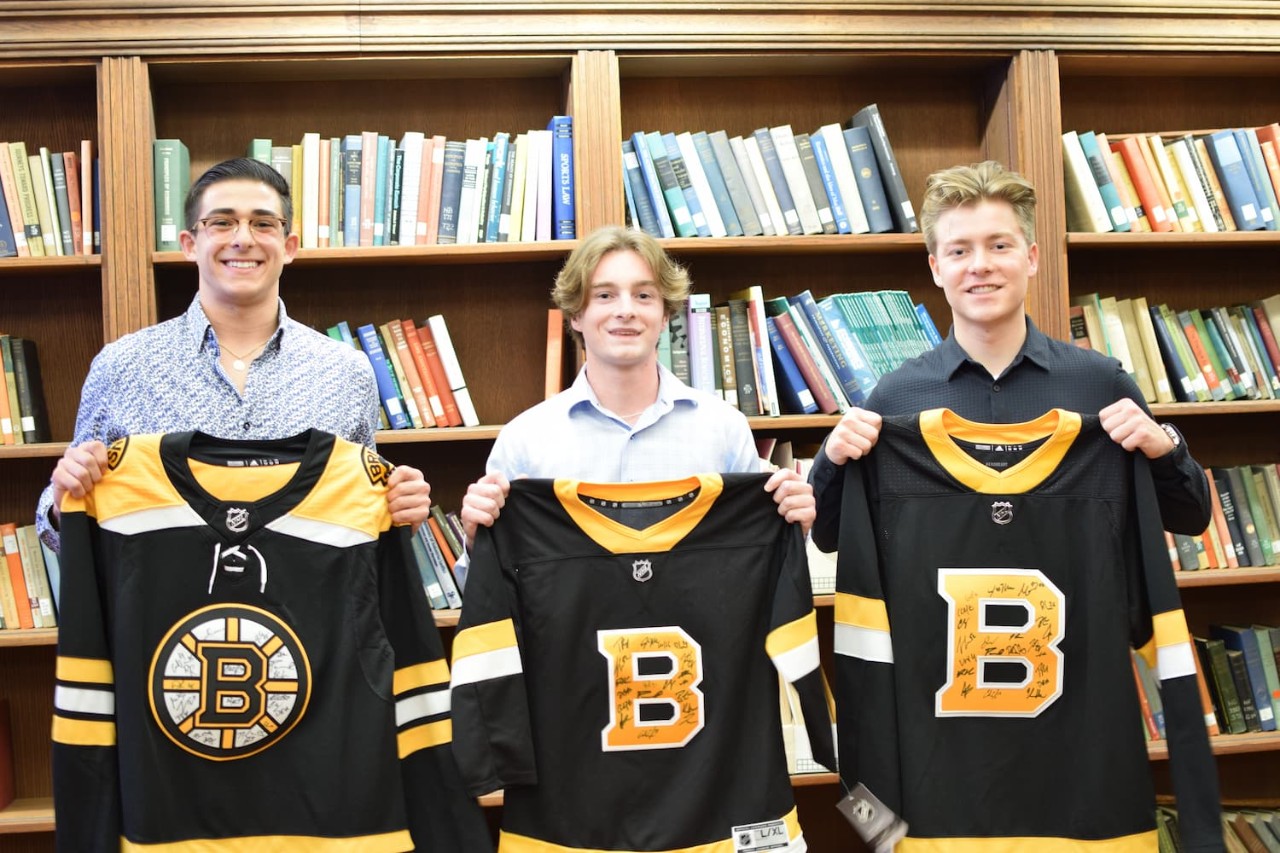Face-Off: NHL, NFTs, and Lots of Ice Time in 2021 Case Competition
In 2020, an inaugural year like no other, we partnered with Drizly to launch the first-ever Shea Center Case Competition. And, as we learned, there are benefits to holding a contest like this online, but there’s a downside too: no facetime with the judges.
So, when Maggie Yan ’22 invited Entrepreneur-in-Residence Ryan Littman-Quinn, Carroll School of Management ‘09, to join her and the Start@Shea executive team to brainstorm 2021 events, she lobbied hard for a local organization that could meet in person. As luck would have it, Littman-Quinn’s sister-in-law just happens to be Boston Bruins Director of Marketing Andrea Mazzarelli. And she just happened to need help solving a problem.
The Puck Drop
In late September, Littman-Quinn set up a call between his sister-in-law and Yan.“Andrea asked me, ‘Would BC students be interested in hockey?’ And I was like, ‘Well, we're a D-1 school and we're pretty good at hockey,’” said Yan.
Within a couple of weeks, Mazzarelli had issued the prompt (let’s call it a puck drop) that would launch the 2021 Case Competition.
It went like this:
Recently many major brands, leagues, teams, athletes, and others in the sports industry have begun to use blockchain technology in creative and unique ways to drive their businesses, specifically through the use of nonfungible tokens (NFTs) or digital collectibles. Bearing in mind best practices from across the sports industry, how should the Boston Bruins use the same technology to enhance its business, such as drive revenue and fan engagement?
The prompt reflects a trend that’s sweeping the major leagues: the use of digital tools to connect with a younger fan base. A recent New York Times article reveals little more than 20 percent of Gen Zers call themselves passionate sports fans versus over 40 percent of Millennials. The NHL, like every other league, is feeling the effects of that waning interest, and the Bruins see NFTs as a way to reignite passion for the sport.
The Game
To “rile up” students to take on the challenge, Yan said they released the prompt at midnight on November 3rd only after registration closed. The game heated up fast from there, with 21 teams signing on.
Next came three rounds (or in NHL parlance, “periods”). First, the teams got three days to submit two-page executive summaries, which were then sent off to the Bruins, names redacted to keep the grading focused solely on the quality of the ideas. The judges also got a rubric for grading the summaries based on criteria like the students’ understanding of the problem and the feasibility of the solution.
The second round saw the top six teams advance to Zoom presentations where students got 10 minutes to present to the judges, followed by a two-minute Q&A.
Four Boston Bruins executives joined Mazzarelli for the judging: Bruins/TD Garden Director of Business Solutions Angie McNew; Bruins Senior Director of Community Relations Kerry Collins; Bruins Director of Corporate Partnerships Mark Kastrud; and Bruins Foundation Executive Director Bob Sweeney ’86, who played hockey for both the Bruins and Boston College. The final round came right before Thanksgiving, narrowing the contestants to the top three teams, who refined their presentations and presented to the judges in person.
The Winners
What made the winning teams rise to the top? Three critical differences, according to Yan: expertise on how to leverage NFTs, out-of-the-box thinking, and a focus on fan engagement.
Understanding a key aspect of the goal—allowing the Bruins to use NFTs without player likeness—also helped. That boundary kept the students focused on the Bruins organization and fan engagement, which led to breakthrough ideas like a virtual locker room where fans can store their NFTs, and NFTs you redeem for a Bruins hat to replace the one you throw on the rink after a hat trick.
Expertise on where to leverage NFTs didn’t hurt either. The winning team clinched 1st prize by referring the judges to Discord, a virtual communication platform where new communities have begun to converge around blockchain, NFTs, and crypto.
Eight CSOM students took top honors. In 1st place were Tristan Bruni ’24, Jack McCarthy ’24, and John “JR” Cagnassola ’24; in 2nd place, Alison Breen ’22, Caroline Costa ’22, and Jackson Recht ’22; and in 3rd place, Isabella DeCurtis ’24 and Makenzie Gorman ’24.
“We were blown away by the professionalism and creativity of all the finalists,” said Mazzarelli. “And I can definitely say we got just as much out of the experience as the students did.”
The Prizes
In exchange for their hard work and ingenuity, the winning teams received $1,000 in cash prizes, with $200 going to the 3rd place team, $300 to 2nd place, and $500 to 1st place. But the bounty didn’t stop there. The Bruins surprised all the winners with signed jerseys and gave the top team a chance to meet one-on-one with the Bruins human resources team for resume and interview advice.
And then came the icing on the cake. On the heels of the final round, the Start@Shea team went out on the BC ice at a men’s hockey game to formally announce the winners of the Bruins case competition, a moment Yan had arranged two weeks prior. The next night, the Bruins organization treated them to game seats in a TD Garden luxury box as an extra show of gratitude.
“We went through the VIP entrance, there was pizza catered for us, and it was all totally unexpected,” said Yan.
The following night, the Bruins flashed the names of the eight winners on the jumbotron. “Everybody was freaking out that their names were in TD Garden,” said Yan.
Given the success of the competition, will the Bruins roll out an NFT marketing plan?
“A couple of NHL teams are already working with NFTs,” said Yan, who sees the value of the case competition growing after only two years. “I think they’re very realistically looking to launch something within the next year.”



